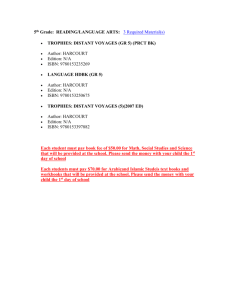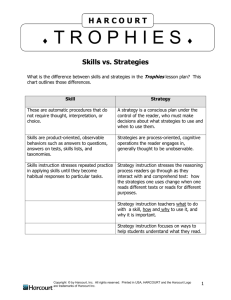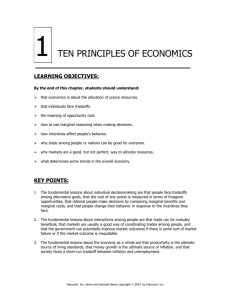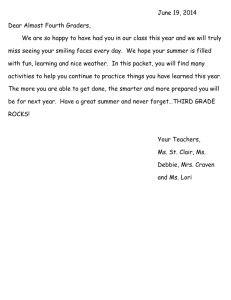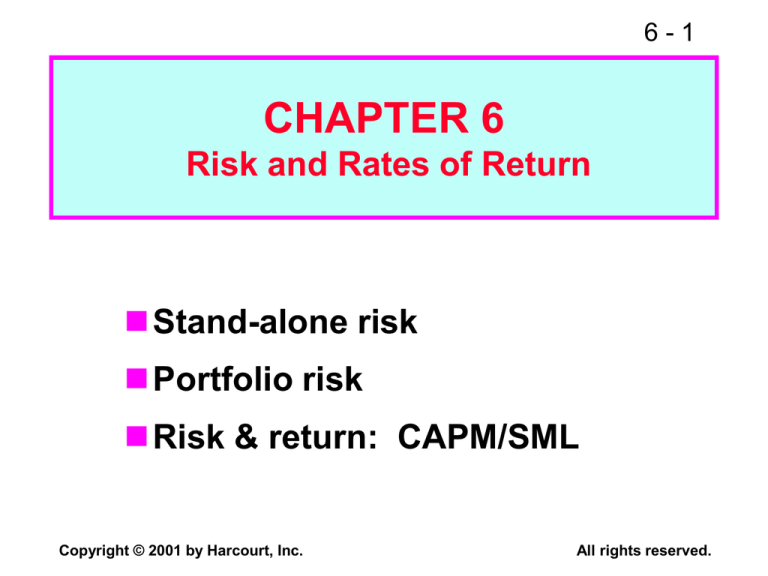
6-1
CHAPTER 6
Risk and Rates of Return
Stand-alone risk
Portfolio risk
Risk & return: CAPM/SML
Copyright © 2001 by Harcourt, Inc.
All rights reserved.
6-2
What is investment risk?
Investment risk pertains to the
probability of actually earning a
low or negative return.
The greater the chance of low or
negative returns, the riskier the
investment.
Copyright © 2001 by Harcourt, Inc.
All rights reserved.
6-3
Probability distribution
Firm X
Firm Y
-70
0
15
100
Rate of
return (%)
Expected Rate of Return
Copyright © 2001 by Harcourt, Inc.
All rights reserved.
6-4
Annual Total Returns,1926-1998
Average
Return
Small-company
stocks
17.4%
Standard
Deviation
Distribution
33.8%
0
Large-company
stocks
13.2
20.3
0
Long-term
corporate bonds 6.1
17.4%
13.2%
8.6
0 6.1%
Long-term
government
5.7
9.2
0 5.7%
Intermediate-term
government
5.5
5.7
0 5.5%
U.S. Treasury
bills
3.8
3.2
0 3.8%
Inflation
3.2
4.5
0 3.2%
Copyright © 2001 by Harcourt, Inc.
All rights reserved.
6-5
Investment Alternatives
(Given in the problem)
Economy Prob. T-Bill
Recession 0.1
Below avg. 0.2
Average
0.4
Above avg. 0.2
Boom
0.1
1.0
HT
Coll
USR
8.0% -22.0% 28.0% 10.0%
8.0
-2.0 14.7 -10.0
8.0 20.0
0.0
7.0
8.0 35.0 -10.0 45.0
8.0 50.0 -20.0 30.0
Copyright © 2001 by Harcourt, Inc.
MP
-13.0%
1.0
15.0
29.0
43.0
All rights reserved.
6-6
Why is the T-bill return independent
of the economy?
Will return the promised 8%
regardless of the economy.
Copyright © 2001 by Harcourt, Inc.
All rights reserved.
6-7
Do T-bills promise a completely
risk-free return?
No, T-bills are still exposed to the
risk of inflation.
However, not much unexpected
inflation is likely to occur over a
relatively short period.
Copyright © 2001 by Harcourt, Inc.
All rights reserved.
6-8
Do the returns of HT and Coll. move
with or counter to the economy?
HT: Moves with the economy, and
has a positive correlation. This is
typical.
Coll: Is countercyclical of the
economy, and has a negative
correlation. This is unusual.
Copyright © 2001 by Harcourt, Inc.
All rights reserved.
6-9
Calculate the expected rate of return
on each alternative:
^
k = expected rate of return.
k P.
n
k̂ =
i i
i =1
^
kHT = (-22%)0.1 + (-2%)0.20
+ (20%)0.40 + (35%)0.20
+ (50%)0.1 = 17.4%.
Copyright © 2001 by Harcourt, Inc.
All rights reserved.
6 - 10
^
k
HT
17.4%
Market
15.0
USR
13.8
T-bill
8.0
Coll.
1.7
HT appears to be the best, but is it
really?
Copyright © 2001 by Harcourt, Inc.
All rights reserved.
6 - 11
What’s the standard deviation
of returns for each alternative?
= Standard deviation.
=
=
Variance =
n
(k
i1
Copyright © 2001 by Harcourt, Inc.
2
k̂) Pi .
2
i
All rights reserved.
6 - 12
n
(k
k̂ ) Pi .
2
i
i1
T-bills
(8.0 – 8.0)20.1 + (8.0 – 8.0)20.2 1/2
= + (8.0 – 8.0)20.4 + (8.0 – 8.0)20.2
2
+ (8.0 – 8.0) 0.1
T-bills = 0.0%.
HT = 20.0%.
Copyright © 2001 by Harcourt, Inc.
Coll = 13.4%.
USR = 18.8%.
M = 15.3%.
All rights reserved.
6 - 13
Prob.
T-bill
USR
HT
0
8
13.8
Copyright © 2001 by Harcourt, Inc.
17.4
Rate of Return (%)
All rights reserved.
6 - 14
Standard deviation (i) measures
total, or stand-alone, risk.
The larger the i , the lower the
probability that actual returns will
be close to the expected return.
Copyright © 2001 by Harcourt, Inc.
All rights reserved.
6 - 15
Expected Returns vs. Risk
Security
HT
Market
USR
T-bills
Coll.
Expected
return
17.4%
15.0
13.8*
8.0
1.7*
Risk,
20.0%
15.3
18.8*
0.0
13.4*
*Seems misplaced.
Copyright © 2001 by Harcourt, Inc.
All rights reserved.
6 - 16
Coefficient of Variation (CV)
Standardized measure of dispersion
about the expected value:
Std dev
CV = Mean = ^ .
k
Shows risk per unit of return.
Copyright © 2001 by Harcourt, Inc.
All rights reserved.
6 - 17
B
A
0
A = B , but A is riskier because larger
probability of losses.
= CVA > CVB.
^
k
Copyright © 2001 by Harcourt, Inc.
All rights reserved.
6 - 18
Portfolio Risk and Return
Assume a two-stock portfolio with
$50,000 in HT and $50,000 in
Collections.
Calculate kp and p.
^
Copyright © 2001 by Harcourt, Inc.
All rights reserved.
6 - 19
^
Portfolio Return, kp
^
kp is a weighted average:
n
^ = S w^
k
p
iki.
i=1
^
kp = 0.5(17.4%) + 0.5(1.7%) = 9.6%.
^
kp is between ^kHT and ^kCOLL.
Copyright © 2001 by Harcourt, Inc.
All rights reserved.
6 - 20
Alternative Method
Economy
Prob.
Recession
0.10
Below avg. 0.20
Average
0.40
Above avg. 0.20
Boom
0.10
Estimated Return
HT
Coll.
Port.
-22.0% 28.0%
3.0%
-2.0
14.7
6.4
20.0
0.0
10.0
35.0
-10.0
12.5
50.0
-20.0
15.0
^
kp = (3.0%)0.10 + (6.4%)0.20 + (10.0%)0.40
+ (12.5%)0.20 + (15.0%)0.10 = 9.6%.
Copyright © 2001 by Harcourt, Inc.
All rights reserved.
6 - 21
p =
1/ 2
(3.0 – 9.6)20.10
+ (6.4 – 9.6)20.20
+ (10.0 – 9.6)20.40 = 3.3%.
+ (12.5 – 9.6)20.20
2
+ (15.0 – 9.6) 0.10
CVp = 3.3% = 0.34.
9.6%
Copyright © 2001 by Harcourt, Inc.
All rights reserved.
6 - 22
p = 3.3% is much lower than that of
either stock (20% and 13.4%).
p = 3.3% is lower than average of
HT and Coll = 16.7%.
^
\ Portfolio provides average k but
lower risk.
Reason: negative correlation.
Copyright © 2001 by Harcourt, Inc.
All rights reserved.
6 - 23
General statements about risk
Most stocks are positively
correlated. rk,m 0.65.
35% for an average stock.
Combining stocks generally lowers
risk.
Copyright © 2001 by Harcourt, Inc.
All rights reserved.
6 - 24
Returns Distribution for Two Perfectly
Negatively Correlated Stocks (r = -1.0) and
for Portfolio WM
Stock W
.
25 .
.
0
.
.
.
25
15
-10
Stock M
.
0
0
Copyright © 2001 by Harcourt, Inc.
25
. 15 . . . . .
15
-10
Portfolio WM
.
.
-10
All rights reserved.
6 - 25
Returns Distributions for Two Perfectly
Positively Correlated Stocks (r = +1.0) and
for Portfolio MM’
Stock M’
Stock M
Portfolio MM’
25
25
25
15
15
15
0
0
0
-10
-10
-10
Copyright © 2001 by Harcourt, Inc.
All rights reserved.
6 - 26
What would happen to the
riskiness of an average 1-stock
portfolio as more randomly
selected stocks were added?
p would decrease because the
added stocks would not be
^
perfectly correlated but kp would
remain relatively constant.
Copyright © 2001 by Harcourt, Inc.
All rights reserved.
6 - 27
Prob.
Large
2
1
0
15
Even with large N, p 20%
Copyright © 2001 by Harcourt, Inc.
All rights reserved.
6 - 28
p (%)
35
Company Specific Risk
Stand-Alone Risk, p
20
Market Risk
0
10
20
30
40
2,000+
# Stocks in Portfolio
Copyright © 2001 by Harcourt, Inc.
All rights reserved.
6 - 29
As more stocks are added, each
new stock has a smaller riskreducing impact.
p falls very slowly after about 10
stocks are included, and after 40
stocks, there is little, if any, effect.
The lower limit for p is about 20%
= M .
Copyright © 2001 by Harcourt, Inc.
All rights reserved.
6 - 30
Stand-alone Market Firm-specific
= risk +
risk
risk
Market risk is that part of a security’s
stand-alone risk that cannot be
eliminated by diversification, and is
measured by beta.
Firm-specific risk is that part of a
security’s stand-alone risk that can be
eliminated by proper diversification.
Copyright © 2001 by Harcourt, Inc.
All rights reserved.
6 - 31
By forming portfolios, we can
eliminate about half the riskiness
of individual stocks (35% vs. 20%).
Copyright © 2001 by Harcourt, Inc.
All rights reserved.
6 - 32
If you chose to hold a one-stock
portfolio and thus are exposed to
more risk than diversified investors,
would you be compensated for all
the risk you bear?
Copyright © 2001 by Harcourt, Inc.
All rights reserved.
6 - 33
NO!
Stand-alone risk as measured by a
stock’s or CV is not important to a
well-diversified investor.
Rational, risk averse investors are
concerned with p , which is based
on market risk.
Copyright © 2001 by Harcourt, Inc.
All rights reserved.
6 - 34
There can only be one price, hence
market return, for a given security.
Therefore, no compensation can be
earned for the additional risk of a
one-stock portfolio.
Copyright © 2001 by Harcourt, Inc.
All rights reserved.
6 - 35
Beta measures a stock’s market risk.
It shows a stock’s volatility relative to
the market.
Beta shows how risky a stock is if
the stock is held in a well-diversified
portfolio.
Copyright © 2001 by Harcourt, Inc.
All rights reserved.
6 - 36
How are betas calculated?
Run a regression of past returns
on Stock i versus returns on the
market. Returns = D/P + g.
The slope of the regression line is
defined as the beta coefficient.
Copyright © 2001 by Harcourt, Inc.
All rights reserved.
6 - 37
Illustration of beta calculation:
_
ki
20
.
15
.
Year kM
1
15%
2
-5
3
12
10
5
-5
0
5
10
Regression line:
^
^
ki = -2.59 + 1.44 k
M
15
20
ki
18%
-10
16
_
kM
-5
.
-10
Copyright © 2001 by Harcourt, Inc.
All rights reserved.
6 - 38
If beta = 1.0, average stock.
If beta > 1.0, stock riskier than
average.
If beta < 1.0, stock less risky than
average.
Most stocks have betas in the range
of 0.5 to 1.5.
Copyright © 2001 by Harcourt, Inc.
All rights reserved.
6 - 39
List of Beta Coefficients
Stock
Merrill Lynch
America Online
General Electric
Microsoft Corp.
Coca-Cola
IBM
Procter & Gamble
Heinz
Energen Corp.
Empire District Electric
Copyright © 2001 by Harcourt, Inc.
Beta
2.00
1.70
1.20
1.10
1.05
1.05
0.85
0.80
0.80
0.45
All rights reserved.
6 - 40
Can a beta be negative?
Answer: Yes, if ri, m is negative. Then
in a “beta graph” the regression line
will slope downward. Though, a
negative beta is highly unlikely.
Copyright © 2001 by Harcourt, Inc.
All rights reserved.
6 - 41
_
ki
HT
b = 1.29
40
b=0
20
T-Bills
-20
0
-20
Copyright © 2001 by Harcourt, Inc.
20
_
kM
40
b = -0.86
Coll.
All rights reserved.
6 - 42
Security
Expected
Return
Risk
(Beta)
17.4%
15.0
13.8
8.0
1.7
1.29
1.00
0.68
0.00
-0.86
HT
Market
USR
T-bills
Coll.
Riskier securities have higher returns,
so the rank order is OK.
Copyright © 2001 by Harcourt, Inc.
All rights reserved.
6 - 43
Use the SML to calculate the
required returns.
SML: ki = kRF + (kM – kRF)bi .
Assume kRF = 8%.
^
Note that kM = kM is 15%. (Equil.)
RPM = kM – kRF = 15% – 8% = 7%.
Copyright © 2001 by Harcourt, Inc.
All rights reserved.
6 - 44
Required Rates of Return
kHT
= 8.0% + (15.0% – 8.0%)(1.29)
= 8.0% + (7%)(1.29)
= 8.0% + 9.0%
= 17.0%.
kM
kUSR
kT-bill
kColl
=
=
=
=
8.0% + (7%)(1.00)
8.0% + (7%)(0.68)
8.0% + (7%)(0.00)
8.0% + (7%)(-0.86)
Copyright © 2001 by Harcourt, Inc.
= 15.0%.
= 12.8%.
= 8.0%.
= 2.0%.
All rights reserved.
6 - 45
Expected vs. Required Returns
^
HT
k
17.4%
k
17.0%
Market
USR
15.0
13.8
15.0
12.8
T-bills
Coll.
8.0
1.7
8.0
2.0
Copyright © 2001 by Harcourt, Inc.
Undervalued:
^>k
k
Fairly valued
Undervalued:
^
k>k
Fairly valued
Overvalued:
^
k<k
All rights reserved.
6 - 46
SML: ki = 8% + (15% – 8%) bi .
ki (%)
SML
.
HT
kM = 15
kRF = 8
.
. .
. T-bills
USR
Coll.
-1
0
Copyright © 2001 by Harcourt, Inc.
1
2
Risk, bi
All rights reserved.
6 - 47
Calculate beta for a portfolio with 50%
HT and 50% Collections
bp= Weighted average
= 0.5(bHT) + 0.5(bColl)
= 0.5(1.29) + 0.5(-0.86)
= 0.22.
Copyright © 2001 by Harcourt, Inc.
All rights reserved.
6 - 48
The required return on the HT/Coll.
portfolio is:
kp = Weighted average k
= 0.5(17%) + 0.5(2%) = 9.5%.
Or use SML:
kp= kRF + (kM – kRF) bp
= 8.0% + (15.0% – 8.0%)(0.22)
= 8.0% + 7%(0.22) = 9.5%.
Copyright © 2001 by Harcourt, Inc.
All rights reserved.
6 - 49
If investors raise inflation
expectations by 3%, what would
happen to the SML?
Copyright © 2001 by Harcourt, Inc.
All rights reserved.
6 - 50
Required Rate
of Return k (%)
D I = 3%
New SML
SML2
SML1
18
15
11
8
Original situation
0
0.5
Copyright © 2001 by Harcourt, Inc.
1.0
1.5
Risk, bi
All rights reserved.
6 - 51
If inflation did not change
but risk aversion increased
enough to cause the market
risk premium to increase by
3 percentage points, what
would happen to the SML?
Copyright © 2001 by Harcourt, Inc.
All rights reserved.
6 - 52
Required
Rate of
Return (%)
After increase
in risk aversion
SML2
kM = 18%
kM = 15%
SML1
18
15
D RPM = 3%
8
Original situation
1.0
Copyright © 2001 by Harcourt, Inc.
Risk, bi
All rights reserved.
6 - 53
Has the CAPM been verified through
empirical tests?
Not completely. Those statistical
tests have problems that make
verification almost impossible.
Copyright © 2001 by Harcourt, Inc.
All rights reserved.
6 - 54
Investors seem to be concerned
with both market risk and total risk.
Therefore, the SML may not
produce a correct estimate of ki:
ki = kRF + (kM – kRF)b + ?
Copyright © 2001 by Harcourt, Inc.
All rights reserved.
6 - 55
Also, CAPM/SML concepts are
based on expectations, yet betas
are calculated using historical data.
A company’s historical data may
not reflect investors’ expectations
about future riskiness.
Copyright © 2001 by Harcourt, Inc.
All rights reserved.


